《西方经济学》课程PPT教学课件(微观经济学)Chapter 17 Microeconomics
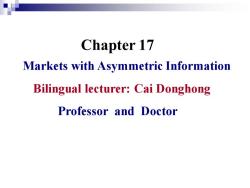
Chapter 17 Markets with Asymmetric Information Bilingual lecturer:Cai Donghong Professor and Doctor
Chapter 17 Markets with Asymmetric Information Bilingual lecturer: Cai Donghong Professor and Doctor
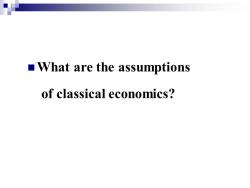
What are the assumptions of classical economics?
◼What are the assumptions of classical economics?
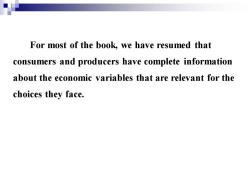
For most of the book,we have resumed that consumers and producers have complete information about the economic variables that are relevant for the choices they face
For most of the book, we have resumed that consumers and producers have complete information about the economic variables that are relevant for the choices they face

Chapter Outline a1 Asymmetric information(非对称信息) 口2 Adverse selection(逆向选择) ▣3 Market Signaling(市场信息传递) 口4 Moral Hazard(道德风险) 口5 The Principal-Agent Problem(倭托代理问题)
1 Asymmetric information (非对称信息) 2 Adverse selection(逆向选择) 3 Market Signaling (市场信息传递) 4 Moral Hazard (道德风险) 5 The Principal-Agent Problem (委托代理问题) Chapter Outline
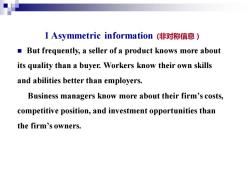
1 Asymmetric information(非对称信息) But frequently,a seller of a product knows more about its quality than a buyer.Workers know their own skills and abilities better than employers. Business managers know more about their firm's costs, competitive position,and investment opportunities than the firm's owners
1 Asymmetric information (非对称信息) ◼ But frequently, a seller of a product knows more about its quality than a buyer. Workers know their own skills and abilities better than employers. Business managers know more about their firm’s costs, competitive position, and investment opportunities than the firm’s owners
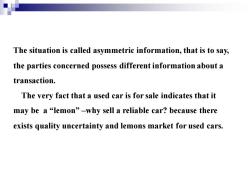
The situation is called asymmetric information,that is to say, the parties concerned possess different information about a transaction. The very fact that a used car is for sale indicates that it may be a "lemon"-why sell a reliable car?because there exists quality uncertainty and lemons market for used cars
The situation is called asymmetric information, that is to say, the parties concerned possess different information about a transaction. The very fact that a used car is for sale indicates that it may be a “lemon” –why sell a reliable car? because there exists quality uncertainty and lemons market for used cars
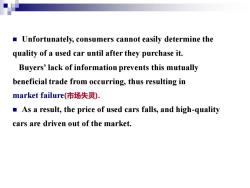
Unfortunately,consumers cannot easily determine the quality of a used car until after they purchase it. Buyers'lack of information prevents this mutually beneficial trade from occurring,thus resulting in market failure(市场失灵). As a result,the price of used cars falls,and high-quality cars are driven out of the market
◼ Unfortunately, consumers cannot easily determine the quality of a used car until after they purchase it. Buyers’ lack of information prevents this mutually beneficial trade from occurring, thus resulting in market failure(市场失灵). ◼ As a result, the price of used cars falls, and high-quality cars are driven out of the market
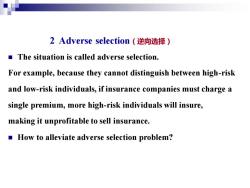
2 Adverse selection(逆向选择) The situation is called adverse selection. For example,because they cannot distinguish between high-risk and low-risk individuals,if insurance companies must charge a single premium,more high-risk individuals will insure, making it unprofitable to sell insurance. How to alleviate adverse selection problem?
2 Adverse selection(逆向选择) ◼ The situation is called adverse selection. For example, because they cannot distinguish between high-risk and low-risk individuals, if insurance companies must charge a single premium, more high-risk individuals will insure, making it unprofitable to sell insurance. ◼ How to alleviate adverse selection problem?
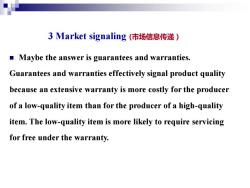
3 Market signaling(市场信息传递) Maybe the answer is guarantees and warranties. Guarantees and warranties effectively signal product quality because an extensive warranty is more costly for the producer of a low-quality item than for the producer of a high-quality item.The low-quality item is more likely to require servicing for free under the warranty
3 Market signaling (市场信息传递) ◼ Maybe the answer is guarantees and warranties. Guarantees and warranties effectively signal product quality because an extensive warranty is more costly for the producer of a low-quality item than for the producer of a high-quality item. The low-quality item is more likely to require servicing for free under the warranty
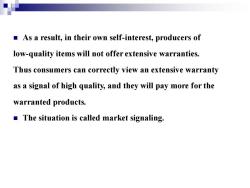
As a result,in their own self-interest,producers of low-quality items will not offer extensive warranties. Thus consumers can correctly view an extensive warranty as a signal of high quality,and they will pay more for the warranted products. The situation is called market signaling
◼ As a result, in their own self-interest, producers of low-quality items will not offer extensive warranties. Thus consumers can correctly view an extensive warranty as a signal of high quality, and they will pay more for the warranted products. ◼ The situation is called market signaling
按次数下载不扣除下载券;
注册用户24小时内重复下载只扣除一次;
顺序:VIP每日次数-->可用次数-->下载券;
- 《西方经济学》课程PPT教学课件(微观经济学)Chapter 18 Externalities.ppt
- 《西方经济学》课程PPT教学课件(微观经济学)Chapter 17 Markets with Asymmetric Information.ppt
- 《西方经济学》课程PPT教学课件(微观经济学)Chapter 16 General Equilibrium and Economic Efficiency.ppt
- 《西方经济学》课程PPT教学课件(微观经济学)Chapter 15 Investment, Time, and Capital.ppt
- 《西方经济学》课程PPT教学课件(微观经济学)Chapter 14 Markets for Factor Inputs.ppt
- 《西方经济学》课程PPT教学课件(微观经济学)Chapter 13 Game Theory.ppt
- 《西方经济学》课程PPT教学课件(微观经济学)Chapter 12 Monopolistic Competition.ppt
- 《西方经济学》课程PPT教学课件(微观经济学)Chapter 11 Pricing with Market Power.ppt
- 《西方经济学》课程PPT教学课件(微观经济学)Chapter 10 Market Power.ppt
- 《西方经济学》课程PPT教学课件(微观经济学)Chapter 09 The Analysis of Competitive Markets.ppt
- 《西方经济学》课程PPT教学课件(微观经济学)Chapter 08 Profit Maximization and Competitive Supply.ppt
- 《西方经济学》课程PPT教学课件(微观经济学)Chapter 07 The Cost of Production.ppt
- 《西方经济学》课程PPT教学课件(微观经济学)Chapter 06 Production.ppt
- 《西方经济学》课程PPT教学课件(微观经济学)Chapter 05 Choice under Uncertainty.ppt
- 《西方经济学》课程PPT教学课件(微观经济学)Chapter 04 Individual and Market Demand.ppt
- 《西方经济学》课程PPT教学课件(微观经济学)Chapter 03 Consumer Behavior.ppt
- 《西方经济学》课程PPT教学课件(微观经济学)Chapter 02 The Basics of Supply and Demand.ppt
- 《西方经济学》课程PPT教学课件(微观经济学)Chapter 01 Preliminaries.ppt
- 《西方经济学》课程PPT教学课件(宏观经济学)Chapter 19 Advances in Business Cycle theory.ppt
- 《西方经济学》课程PPT教学课件(宏观经济学)Chapter 17 Investment.ppt
- 海南大学:《成本会计》课程课程教学大纲 COST ACCOUNTING.pdf
- 海南大学:《成本会计》课程教学资源(教案讲义)第一章 总论.doc
- 海南大学:《成本会计》课程教学资源(教案讲义)第三章 成本汇集与分配.doc
- 海南大学:《成本会计》课程教学资源(教案讲义)第二章 成本核算方法体系.doc
- 海南大学:《成本会计》课程教学资源(教案讲义)第五章 分步成本计算.doc
- 海南大学:《成本会计》课程教学资源(教案讲义)第六章 分类法.doc
- 海南大学:《成本会计》课程教学资源(教案讲义)第四章 单步骤成本计算方法.doc
- 海南大学:《成本会计》课程教学资源(教案讲义)第七章 作业成本计算.doc
- 海南大学:《成本会计》课程教学资源(教案讲义)第九章 标准成本法.doc
- 海南大学:《成本会计》课程教学资源(教案讲义)第十章 成本报表与成本分析.doc
- 海南大学:《成本会计》课程教学资源(试卷习题)各章题库(含参考答案).doc
- 海南大学:《成本会计》课程教学资源(PPT课件)Chapter 01 成本的涵义、分类和作用(主讲:董建华).ppt
- 海南大学:《成本会计》课程教学资源(PPT课件)Chapter 02 产品成本核算概述.ppt
- 海南大学:《成本会计》课程教学资源(PPT课件)Chapter 03 要素费用的归集与分配.ppt
- 海南大学:《成本会计》课程教学资源(PPT课件)Chapter 04 辅助生产成本与制造费用的核算.ppt
- 海南大学:《成本会计》课程教学资源(PPT课件)Chapter 05 成本计算品种法.ppt
- 海南大学:《成本会计》课程教学资源(PPT课件)Chapter 06 产品计算分批法.ppt
- 海南大学:《成本会计》课程教学资源(PPT课件)Chapter 07 废品、返工品和残料 Spoilage, Rework and Scrap.ppt
- 海南大学:《成本会计》课程教学资源(PPT课件)Chapter 08 产品计算分步法.ppt
- 海南大学:《成本会计》课程教学资源(PPT课件)Chapter 09 分类法.ppt
